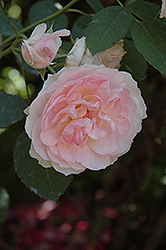It's all about ...
plants

Height: 4 feet
Spread: 3 feet
Sunlight:
![]()
Hardiness Zone: 5a
Group/Class: Buck Rose
Description:
A wonderfully fragrant double rose that starts a playful rose pink and fades to a lighter shade of pink towards the outer petals, repeat blooming; all roses need full sun and well-drained soil
Ornamental Features
Aunt Honey Rose is blanketed in stunning fragrant rose flowers with pink overtones at the ends of the branches from late spring to late summer. The flowers are excellent for cutting. It has dark green deciduous foliage. The oval compound leaves turn yellow in fall. The spiny brick red bark adds an interesting dimension to the landscape.
Landscape Attributes
Aunt Honey Rose is a multi-stemmed deciduous shrub with an upright spreading habit of growth. Its average texture blends into the landscape, but can be balanced by one or two finer or coarser trees or shrubs for an effective composition.
This is a high maintenance shrub that will require regular care and upkeep, and is best pruned in late winter once the threat of extreme cold has passed. Gardeners should be aware of the following characteristic(s) that may warrant special consideration;
- Disease
- Spiny
Aunt Honey Rose is recommended for the following landscape applications;
- Mass Planting
- Hedges/Screening
- General Garden Use
Planting & Growing
Aunt Honey Rose will grow to be about 4 feet tall at maturity, with a spread of 3 feet. It tends to fill out right to the ground and therefore doesn't necessarily require facer plants in front. It grows at a fast rate, and under ideal conditions can be expected to live for approximately 20 years.
This shrub should only be grown in full sunlight. It does best in average to evenly moist conditions, but will not tolerate standing water. It is not particular as to soil type or pH. It is somewhat tolerant of urban pollution. This particular variety is an interspecific hybrid.
This plant is not reliably hardy in our region, and certain restrictions may apply; contact the store for more information.
